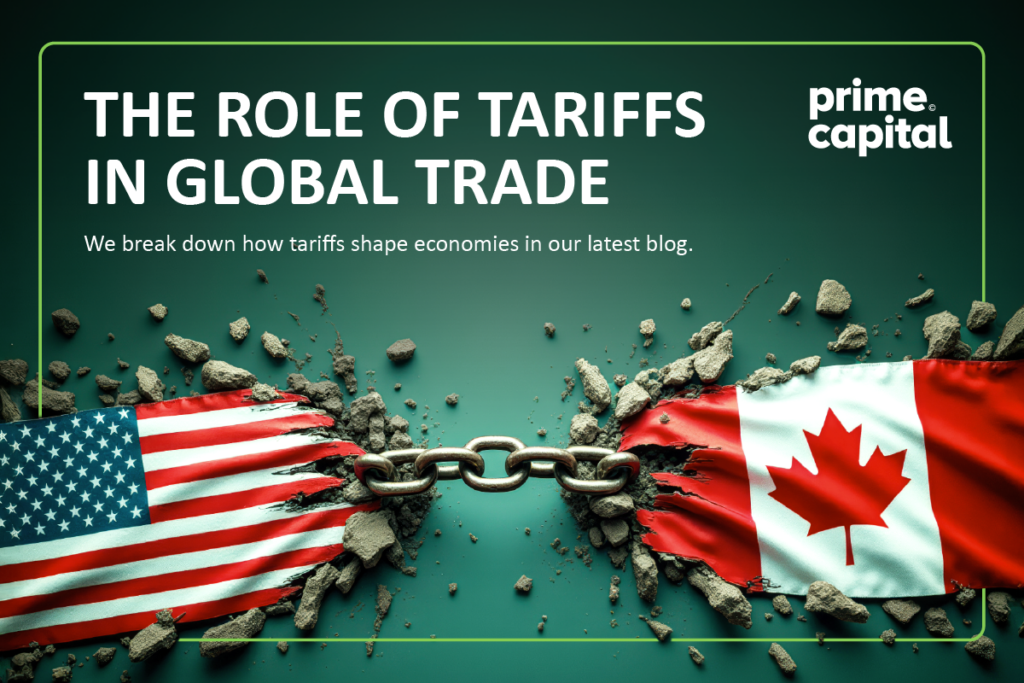Tariffs are one of the most debated tools in international trade policy, influencing everything from government revenue to consumer prices and global trade relationships. For Canadian businesses engaged in cross-border trade, understanding tariffs is crucial to navigating economic shifts and ensuring long-term stability.
In this article, we’ll break down what tariffs are, why governments use them, and how they impact businesses, consumers, and the economy as a whole.
What Are Tariffs?
A tariff is a tax imposed by a government on imported or exported goods. The purpose of tariffs is to regulate trade by making foreign products more expensive, thereby encouraging consumers to purchase domestic alternatives.
Types of Tariffs
- Ad Valorem Tariffs – A percentage of the product’s value (e.g., a 10% tariff on imported cars).
- Specific Tariffs – A fixed fee per unit (e.g., $5 per barrel of imported oil).
- Tariff-Rate Quotas – A hybrid approach where a certain quantity of goods is taxed at a lower rate, with a higher tariff applied to additional imports.
Example: Canada has historically imposed tariffs on dairy imports to protect its domestic dairy industry, while the U.S. has applied tariffs on aluminum and steel imports for national security reasons.
Why Do Governments Use Tariffs?
While tariffs may seem like a simple taxation tool, they serve multiple economic and political purposes.
1. Revenue Generation
Historically, tariffs were a major source of government income before income taxes were introduced. While this is less common today in developed economies, some countries still rely on tariffs to fund public services.
2. Protecting Domestic Industries
Governments use tariffs to shield domestic manufacturers from international competition. For example, if Canadian steel manufacturers struggle to compete with cheaper Chinese imports, tariffs can make foreign steel more expensive, giving local producers an advantage.
3. Reducing Trade Deficits
A country with a large trade deficit (importing more than it exports) may impose tariffs to encourage domestic production and balance its economy.
4. National Security and Strategic Interests
Some industries, such as energy, defense, and technology, are considered crucial to national security. Tariffs on these sectors may prevent reliance on foreign suppliers and encourage domestic innovation.
5. Political Leverage in Trade Negotiations
Tariffs can be used as a bargaining tool in trade agreements. For example, in 2018, the U.S. imposed tariffs on Canadian steel and aluminum, which influenced negotiations around the Canada-United States-Mexico Agreement (CUSMA).
How Tariffs Impact the Economy
While tariffs are meant to benefit domestic industries, their effects ripple through the economy in both positive and negative ways.
1. Effects on Businesses
- For Domestic Producers: Tariffs can help local businesses by reducing foreign competition. However, this protection is not always sustainable if it leads to inefficiencies.
- For Import-Dependent Businesses: Companies that rely on foreign raw materials or components face higher production costs, which may be passed on to consumers or lead to job cuts to maintain profit margins.
Example: Canada’s automotive industry relies on cross-border supply chains, with car parts crossing between Canada, the U.S., and Mexico multiple times before final assembly. Tariffs disrupt this efficiency, leading to higher costs.
2. Impact on Consumers
- Higher Prices: Tariffs make imported goods more expensive, increasing costs for everyday products like food, electronics, and clothing.
- Reduced Choices: Companies may scale back imports or discontinue products, leading to fewer options for consumers.
3. Job Market Implications
- Short-Term Job Protection: Domestic industries may see job growth due to reduced foreign competition.
- Long-Term Job Losses: If tariffs lead to retaliatory measures from other countries, export-reliant industries (such as Canadian agriculture and energy) could suffer job losses.
4. Trade Wars and Economic Retaliation
- Countries affected by tariffs often respond with their own tariffs, leading to economic strain on both sides.
- Example: In 2018, China imposed tariffs on U.S. soybeans in response to U.S. tariffs on Chinese goods, which severely impacted American farmers.
The Canadian Perspective: How Tariffs Affect Canada’s Economy
Canada is heavily dependent on international trade, with approximately 75% of its exports going to the United States in 2022, according to Statistics Canada. This means any shifts in U.S. trade policy—such as proposed tariff increases—can have significant consequences.
Key Canadian Industries at Risk
- Energy Products (Oil & Gas) – In 2022, Canada exported $165.9 billion CAD worth of energy products, 88.5% of which went to the U.S. Tariffs on oil would increase costs for American refineries but could reduce revenue for Canadian producers.
- Automotive Sector – Nearly 94.6% of Canada’s motor vehicle and parts exports went to the U.S. in 2022, amounting to $82.2 billion CAD. Tariffs would raise prices for consumers and disrupt North American supply chains.
- Agriculture and Consumer Goods – Canada exported $60.5 billion CAD in farm and food products in 2022, 46.5% of which went to the U.S. Tariffs could make these products more expensive for American consumers.
What Can Businesses Do to Navigate Tariffs?
While businesses cannot control government policies, they can take proactive steps to mitigate risks:
✅Diversify Markets
- Expand trade relationships beyond the U.S. to reduce reliance on a single market.
- Explore opportunities in Europe and Asia, where trade agreements like CETA and CPTPP provide lower tariffs.
✅ Optimize Supply Chains
- Shift sourcing to countries with favorable trade agreements.
- Consider setting up U.S.-based operations to avoid import tariffs on Canadian goods.
✅ Monitor Policy Changes
- Stay informed on trade policy developments.
- Work with financial experts to model potential tariff impacts and adjust pricing strategies accordingly.
✅ Leverage Financial Solutions
- Prime Capital can help businesses secure financing for expansion, supply chain adjustments, or operational changes to remain competitive amid tariff uncertainties.
Conclusion
Tariffs are a powerful economic tool that shape industries, influence consumer behavior, and drive political negotiations. While they can protect domestic industries, they also raise prices, disrupt supply chains, and trigger economic retaliation.
For Canadian businesses, being proactive is key. Understanding how tariffs work and preparing for potential trade shifts can minimize risk and create new growth opportunities.
🔹 Need expert guidance on navigating tariffs? Contact Prime Capital for insights on financing strategies to help your business thrive in a changing trade environment.
Sources & References:
- Canadian International Merchandise Trade Report (2022): www150.statcan.gc.ca
- Trade and Investment Agreements – Canada.ca: international.canada.ca
- Tariffs, Rules, and Regulations – Canada.ca:
international.canada.ca - Comprehensive and Progressive Agreement for Trans-Pacific Partnership (CPTPP): canada.ca
- About Canada’s Trade Policy – Canada.ca: international.canada.ca
- Canadian International Merchandise Trade: www150.statcan.gc.ca
- Canadian International Merchandise Trade, December 2022: www150.statcan.gc.ca
- International Trade Statistics – Statistics Canada: statcan.gc.ca





